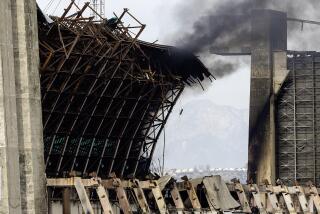Asbestos from steam blast not serious, officials say
- Share via
NEW YORK — Trace amounts of asbestos were found in the dust and muddy debris that rained down on people fleeing a steam pipe explosion, but city officials said Thursday that the exposure posed very little health risk to those caught in the fallout.
Citing environmental tests by the city and the utility Con Edison, Mayor Michael R. Bloomberg sought to allay the chief fear among those who were near the blast: exposure to cancer-causing asbestos that was used to insulate the 83-year-old pipe.
No asbestos was detected in 12 air samples tested so far, but 14 of 56 debris samples showed evidence of the toxin. In all but two samples, the amounts were tiny, Bloomberg said.
“Let me repeat, every single test of the air showed no asbestos,” the mayor said at a news conference Thursday night.
Health experts say any exposure to airborne asbestos is a risk, although most long-term health problems from the toxin are the result of extended, industrial-level exposure.
Meanwhile, those who live and work in Midtown Manhattan encountered major disruptions.
Subway service was restored by midday Thursday, and 3rd Avenue was expected to reopen to vehicular traffic today. But streets by the blast site were a maze of police barricades that stymied commuters and tourists.
The mayor suggested that the cleanup -- and the street closures -- would stretch well into next week, if not longer. Building owners need to clean up and test structures’ interiors before reopening.
“It’s going to take several days, and that’s the best-case scenario,” Bloomberg said. “But we will not compromise safety. We will do it as quickly as we can, but safety is our No. 1 priority.”
Police officers guarding closed streets wore respirator masks, and the Red Cross reported having distributed about 1,200 dust masks to city workers and commuters since Wednesday night.
Con Edison officials were still investigating the cause of the rupture but have said cold water from heavy rains might have created condensation on the pipe, and a sudden change in temperature and pressure.
The utility set up mobile consumer centers in Midtown for people showered with dust or debris to drop off soiled belongings for disposal and apply for reimbursement.
Forty-five people were injured in the incident. The explosion blew a wide hole in a section of 41st Street near Lexington Avenue. A geyser of steam and asphalt shot 150 feet into the air.
Tow truck driver Gregory McCullough, 21, was passing through Midtown on Wednesday after dropping off his last customer when his cherry-red truck got caught in the explosion.
McCullough, an aspiring Marine and law enforcement agent, was hospitalized in critical condition. He was in an induced coma with burns on 80% of his body, doctors said.
His truck was buried in the blast crater.
Lois Baumerich, 51, a Pfizer employee from Hawthorne, N.J., died of cardiac arrest while being evacuated from the scene. No one else has died.
More to Read
Sign up for Essential California
The most important California stories and recommendations in your inbox every morning.
You may occasionally receive promotional content from the Los Angeles Times.










